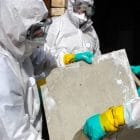How to Identify Asbestos?
Everybody knows asbestos can be a hidden health hazard in older homes, causing concerns for many homeowners… or do they? At Ryno’s, we are flabbergasted by the number of stories we hear of homes, commercial spaces, and even schools containing deadly asbestos materials. It’s a reminder that this hazardous material can be closer than we think and can lurk in places you would never expect.
Now, we understand this can be scary stuff. But before you hit the panic button, let’s take a deep breath together. Here at Ryno’s Asbestos Removal, we’re here to be your partner in navigating this.
The good news? With a bit of knowledge, you can be proactive about protecting your family. This blog will guide you through identifying potential asbestos in your home and explain why professional testing is often the best course of action. So, let’s shed some light on this issue and empower you to breathe a little easier!
What is Asbestos?
Asbestos might sound like a scary monster lurking in your home, but it’s actually a group of naturally occurring minerals. These minerals were super popular in construction back in the day because they were fire-resistant and tough.
The issue? When disturbed, asbestos releases tiny fibres that can cause serious health problems. The good news is that modern materials have replaced asbestos, and most asbestos removal companies, like Ryno’s here in Newcastle, ensure safe removal and responsible recycling into non-harmful products.
Where is it Found?
As mentioned, asbestos was once a construction all-star, used in everything from roof shingles (think cement!) to electrical wiring insulation.
Floor tiles? Yep, sometimes. Even furnace parts could contain asbestos. The key thing to remember? Asbestos itself doesn’t pose a threat, but disturbing it can release harmful fibres. That’s why proper identification is key. Now, let’s get to the real question: how can you identify this stuff in your home?
Types of Asbestos:
Asbestos might be a group term, but there are actually six different types, each with its own favourite hiding spots in your home. Knowing a bit about these asbestos varieties can help you stay calm and collected.
Chrysotile (White Asbestos): This is the most common type, lurking in ceilings, walls, and insulation (think popcorn ceilings!). You might also find it in hidden places like boiler parts and brake linings.
Crocidolite (Blue Asbestos): Less common than white asbestos, this blue variety was used in pipe insulation, cement products, and some plastics. The good news – it’s not typically found in everyday areas like walls or floors.
Amosite (Brown Asbestos): Another common type, brown asbestos, was a favourite in cement sheets and pipe insulation. It also found its way into ceiling tiles, making it important to be cautious during renovations.
Anthophyllite (Greenish-Grey/White Asbestos): This less frequent type can be found in insulation and construction materials. Inhaling its needle-like fibres can cause serious health problems.
Actinolite (Dark Asbestos): This one likes to hide in older building materials like cement, insulation, and paint. Just like the others, disturbing it can release harmful fibres.
Tremolite (White/Green/Grey/Transparent Asbestos): This variety is uncommon in buildings but can contaminate talc and insulation products.
Now, remember – identifying the exact type of asbestos isn’t the issue at hand. What matters is knowing you might have it and taking the right steps. That’s where Ryno’s comes in! We can assess the situation and get rid of any asbestos worries you might have.
Why is it Harmful?
Asbestos fibres are tiny, but their health effects are anything but small. Inhaling them can lead to serious health problems down the line, including lung cancer. But lung cancer isn’t the only worry. Asbestos exposure can also cause mesothelioma, a nasty cancer that attacks the lining of your organs, often targeting the lungs.
On top of that, there’s asbestosis, a chronic lung condition that makes breathing extremely difficult. A constant feeling of being winded or having a cough that just won’t quit.
That’s why it’s important to be aware of asbestos in your home and take action if you suspect it might be there. Ryno’s can help with both – identification and safe removal.
Is Testing the Answer?
Spotting asbestos in your home can be tricky. Construction zones with dust and debris are a red flag, but asbestos can also lurk hidden in older materials. So, how do you know for sure?
Testing is your best bet. Professional labs use innovative equipment (think super-powered microscopes) to analyse samples and identify asbestos fibres. It’s the most reliable way to get a clear answer and peace of mind.
Sure, the internet might be full of DIY identification tips, but trust us, it’s not worth the risk. Testing is affordable and provides a definitive answer. Don’t gamble with your health—our certified professionals will take the guesswork out of it, leaving you with a clear answer and a safe home. Contact Ryno’s today—breathe easy—it’s the healthy choice!



